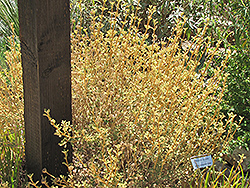It's all about ...
plants

Height: 24 inches
Spread: 4 feet
Sunlight:
![]()
Hardiness Zone: (annual)
Other Names: Small Jerusalem Sage
Brand: Monrovia
Description:
An interesting clump forming perennial with dense whorls of bright yellow flowers that rise on the stems; silvery gray-green woolly leaves are interesting all season; woody and evergreen in zone 8 to 9, but restarts from the ground in colder climates
Ornamental Features
Woolly Jerusalem Sage features bold spikes of yellow hooded flowers held atop the stems from late spring to late summer. The flowers are excellent for cutting. Its tomentose oval leaves remain grayish green in colour throughout the year.
Landscape Attributes
Woolly Jerusalem Sage is an herbaceous annual with an upright spreading habit of growth. Its medium texture blends into the garden, but can always be balanced by a couple of finer or coarser plants for an effective composition.
This is a relatively low maintenance plant, and is best pruned in late winter once the threat of extreme cold has passed. Deer don't particularly care for this plant and will usually leave it alone in favor of tastier treats. It has no significant negative characteristics.
Woolly Jerusalem Sage is recommended for the following landscape applications;
- Mass Planting
- General Garden Use
Planting & Growing
Woolly Jerusalem Sage will grow to be about 24 inches tall at maturity, with a spread of 4 feet. Although it's not a true annual, this plant can be expected to behave as an annual in our climate if left outdoors over the winter, usually needing replacement the following year. As such, gardeners should take into consideration that it will perform differently than it would in its native habitat.
This plant should only be grown in full sunlight. It prefers dry to average moisture levels with very well-drained soil, and will often die in standing water. It is not particular as to soil type or pH. It is somewhat tolerant of urban pollution. This species is not originally from North America.

